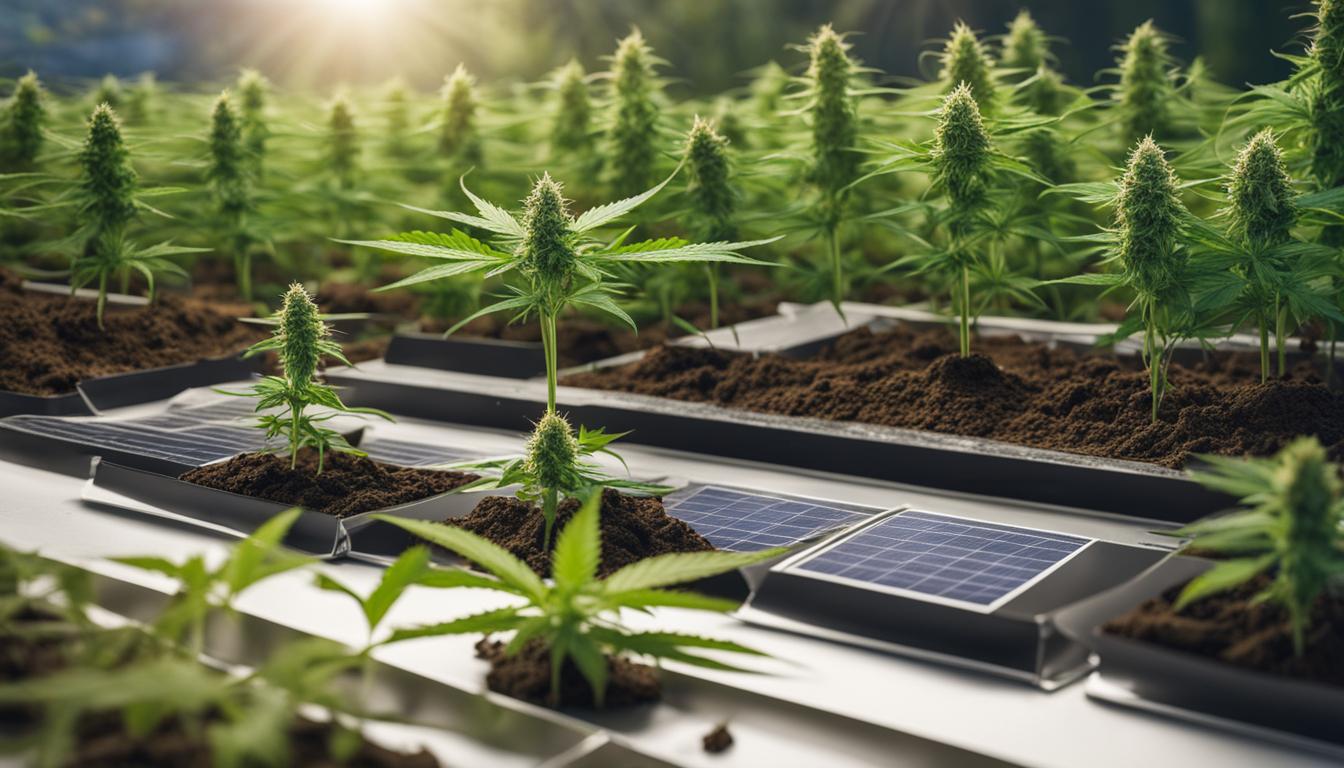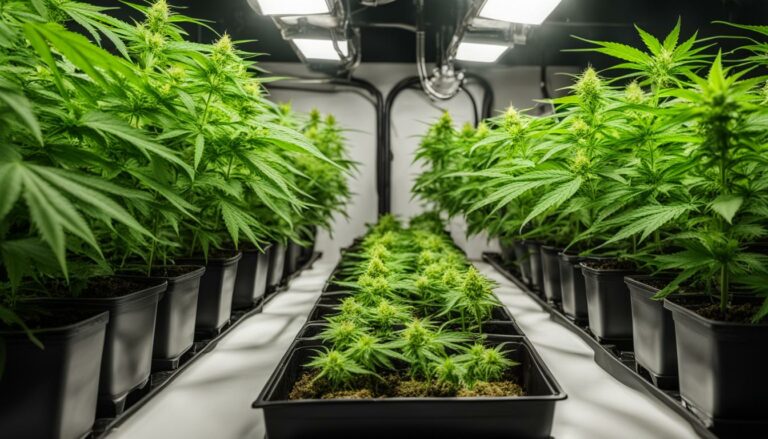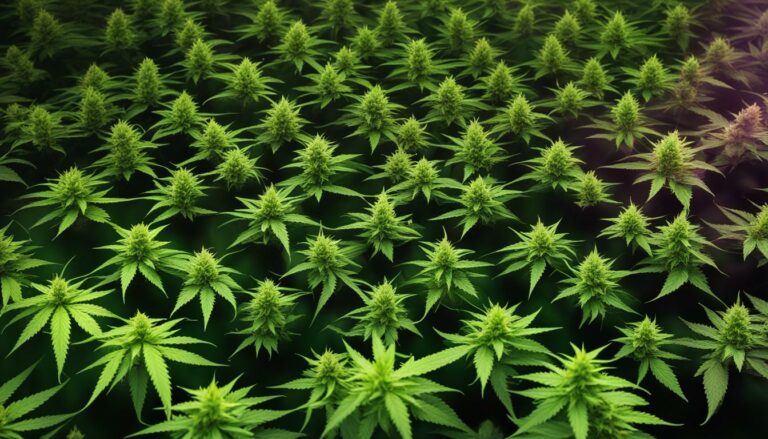Sustainable Practices in Cannabis Cultivation
As the cannabis industry continues to grow, it is essential for growers to embrace sustainable practices that minimize their environmental impact. Sustainable cannabis cultivation encompasses a range of eco-friendly methods and techniques that promote organic and environmentally-conscious growing.
By adopting these sustainable cultivation practices, cannabis farmers can contribute to a greener future. From reducing energy consumption and water usage to implementing waste management strategies, every step towards sustainability counts.
In this article, we will explore various aspects of sustainable cannabis farming, including energy efficiency, water conservation, air emissions reduction, waste management, regenerative farming, and the role of solar energy. Together, these practices aim to create a more environmentally-friendly approach to cannabis production.
With a focus on sustainability, the cannabis industry can minimize its carbon footprint and set an example for other agricultural sectors. Let’s delve into the world of sustainable cannabis cultivation and discover how growers can make a positive impact on the planet.
The Environmental Impact of Cannabis Cultivation
The cannabis industry has gained significant attention in recent years, but alongside its growth comes concerns about its environmental impact. Cannabis cultivation, like any agricultural practice, has implications for energy consumption, water usage, emissions, and waste generation. Understanding and addressing these environmental challenges is crucial for the long-term sustainability of the industry.
Cannabis cultivation consumes a considerable amount of energy, especially in indoor operations where artificial lighting, heating, and cooling systems are used. This energy demand contributes to greenhouse gas emissions and reliance on non-renewable resources. Additionally, the water requirements for cannabis cultivation can place strain on local water supplies, particularly in water-scarce regions. Without proper management, excessive water usage can lead to environmental degradation and water shortages.
“The cannabis industry has a significant environmental footprint, with high energy consumption, water usage, emissions, and waste generation.”
The emissions from cannabis farming also contribute to air pollution. Fertilizer and pesticide applications, as well as the combustion of fossil fuels in production and transportation processes, release pollutants into the atmosphere. As the industry expands, regulating and reducing these emissions is crucial for preserving air quality and minimizing its impact on public health.
Another significant concern is the generation of waste within the cannabis industry. This includes consumer packaging, plant waste, and electronic waste from production facilities. Without proper waste management practices, these materials can end up in landfills or contribute to pollution. Implementing sustainable packaging solutions and recycling programs can help mitigate the environmental impact of waste generated by the industry.
Table: Environmental Impact of Cannabis Cultivation
| Environmental Impact | Description |
|---|---|
| Energy Consumption | Significant energy demand due to artificial lighting and environmental controls in indoor cultivation |
| Water Usage | Can strain local water supplies and contribute to water scarcity |
| Emissions | Release of pollutants from fertilizer and pesticide use, as well as energy consumption |
| Waste Generation | Consumer packaging, plant waste, and electronic waste add to the industry’s overall waste output |
Addressing the environmental impact of cannabis cultivation requires a multi-faceted approach. Industry stakeholders, regulators, and cannabis growers must collaborate to develop and implement sustainable practices. This includes adopting energy-efficient technologies, improving water management strategies, implementing emissions reduction measures, and promoting responsible waste management.
While challenges exist, there is growing recognition of the need for sustainable practices in the cannabis industry. By prioritizing environmental stewardship, the industry can minimize its impact, protect natural resources, and contribute to a greener future.
Sustainable Energy Practices in Cannabis Cultivation
The cannabis industry’s energy consumption is a significant environmental concern, particularly in indoor cultivation. To address this issue, growers are increasingly exploring sustainable energy practices to reduce their carbon footprint and lower operating costs. One promising solution is the use of LED lights in cannabis production, which offers energy efficiency benefits compared to traditional lighting systems.
LED Lights: Illuminating the Way to Energy Efficiency
LED lights have emerged as a game-changer in cannabis cultivation due to their energy-saving capabilities. Unlike traditional high-pressure sodium (HPS) lights, LED lights consume less electricity and emit less heat, resulting in reduced energy consumption and cooling needs. This technology allows growers to optimize light intensity, spectrum, and duration, leading to healthier plants and higher yields.
Furthermore, LED lights offer longer lifespans, reducing maintenance costs and waste associated with frequent bulb replacements. By switching to LED lighting systems, cannabis cultivators can significantly reduce their energy consumption and carbon dioxide emissions, contributing to a more sustainable industry.
“We have seen a notable reduction in our energy bills since transitioning to LED lights. Not only have we lowered our environmental impact, but we have also improved our bottom line.” – Cannabis cultivator
However, retrofitting existing facilities with LED lights can be costly. Many growers are hesitant to invest in this technology due to upfront expenses. Nevertheless, as LED technology advances and prices continue to drop, it is becoming an increasingly viable option for sustainable energy practices in cannabis cultivation. Continued research and industry collaboration are essential to optimize LED lighting systems and make them more accessible to growers.
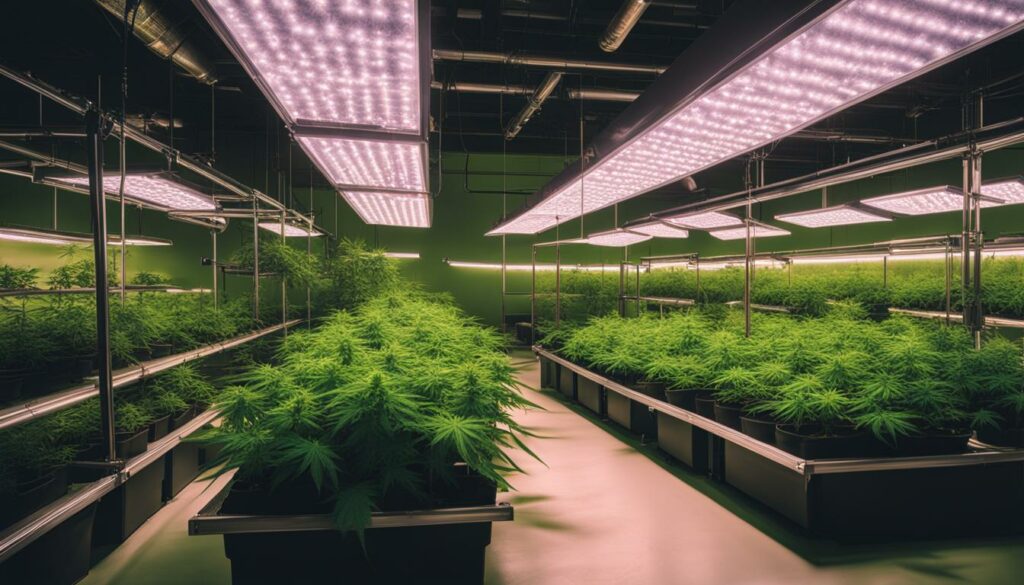
| Benefits of LED Lights in Cannabis Cultivation | Traditional HPS Lights | LED Lights |
|---|---|---|
| Energy consumption | High | Significantly reduced |
| Heat emission | High | Low |
| Lifespan | Short | Long |
| Maintenance costs | High | Low |
| Carbon dioxide emissions | Higher | Lower |
Table: A comparison of traditional HPS lights and LED lights in cannabis cultivation.
Water Conservation in Cannabis Farming
Water management is a crucial aspect of sustainable cannabis cultivation. With the industry’s rising water usage, implementing sustainable irrigation practices is essential to reduce water consumption and minimize environmental impact. By adopting innovative techniques and technologies, cannabis growers can optimize water usage, conserve this precious resource, and promote long-term sustainability.
One effective method of reducing water usage in cannabis production is through the use of automated irrigation systems. These systems allow for precise control over water application, ensuring that plants receive the optimal amount of water without any wastage. By utilizing sensors and data analysis, growers can monitor soil moisture levels, weather conditions, and plant requirements, enabling them to make informed decisions regarding irrigation scheduling and water distribution. This not only conserves water but also ensures that plants receive the necessary hydration for healthy growth.
“We have seen a significant reduction in water usage since implementing automated irrigation systems. The precise control over water application has allowed us to optimize our irrigation cycles and minimize excess water runoff.” – John Smith, Sustainable Cannabis Grower
Another sustainable irrigation practice in cannabis farming is the recapture and reuse of water. This involves collecting and treating runoff water, rainwater, or excess irrigation water and redistributing it back into the cultivation system. By implementing water capture systems and implementing proper filtration and treatment processes, growers can reduce the reliance on freshwater sources and minimize water waste.
Table: Water Conservation Techniques in Cannabis Farming
| Technique | Description |
|---|---|
| Automated Irrigation Systems | Utilize sensors and data analysis to deliver precise amounts of water to plants, minimizing wastage and optimizing water usage. |
| Water Recapture and Reuse | Collect and treat runoff water, rainwater, or excess irrigation water for redistribution within the cultivation system, reducing reliance on freshwater sources and minimizing water waste. |
| Drip Irrigation | Deliver water directly to the plant’s root zone, reducing evaporation and ensuring efficient water utilization. |
| Xeriscaping | Design landscapes with drought-resistant plants and utilize mulching techniques to conserve moisture and minimize water requirements. |
Implementing sustainable water management practices is not only beneficial for the environment but also for the long-term viability of the cannabis industry. By reducing water usage, cannabis growers can contribute to water conservation efforts and mitigate potential water scarcity issues. Additionally, adopting these practices can lead to cost savings and operational efficiencies, making sustainable irrigation methods a win-win solution for both growers and the planet.
Air Quality in Cannabis Farming: Sustainable Practices for Reducing Emissions
When it comes to cannabis cultivation, addressing air pollution and reducing emissions is crucial for promoting sustainable practices in the industry. The production and processing of cannabis can contribute to various air pollutants, including volatile organic compounds (VOCs), particulate matter, and odor. To mitigate these environmental impacts, cannabis growers are implementing sustainable air quality practices that focus on reducing emissions and improving indoor air quality.
The Impact of Air Pollution in Cannabis Farming
Air pollution from cannabis cultivation can have several negative effects on the environment and public health. Studies have shown that VOC emissions from cannabis plants can contribute to the formation of ground-level ozone, a harmful air pollutant that can cause respiratory problems and damage crops. Additionally, the odor generated by cannabis farms can lead to odor complaints from nearby communities, affecting the quality of life for residents.
“The cannabis industry has an opportunity to lead the way in adopting sustainable air quality practices that protect both the environment and the surrounding communities.”
To address these challenges, regulators and industry stakeholders are actively working together to develop and implement sustainable air quality practices. These practices aim to reduce emissions, control odor, and ensure compliance with local air quality regulations.
Sustainable Air Quality Practices in Cannabis Production
One of the key strategies for reducing air pollution in cannabis farming is implementing advanced air filtration systems. These systems effectively capture and filter out air pollutants, including VOCs and particulate matter, ensuring that the air released from cannabis facilities meets the required air quality standards. Furthermore, using high-efficiency ventilation systems can help prevent the buildup of pollutants within indoor cultivation spaces, maintaining a healthy and clean environment.
Another important aspect of sustainable air quality practices in cannabis production is the use of odor control technologies. Activated carbon filters and ozone generators are commonly employed to neutralize and remove odorous compounds, minimizing the impact on surrounding communities. By implementing these technologies, cannabis growers can mitigate odor-related concerns and improve the overall environmental performance of their operations.
Sustainable Packaging and Waste Management in the Cannabis Industry
The cannabis industry has recognized the need to address waste generation and promote sustainable practices. With the growing popularity of cannabis products, it is crucial to find ways to reduce waste, implement proper waste disposal methods, and utilize sustainable packaging in cannabis cultivation.
Waste reduction in cannabis production is a priority for environmentally conscious growers. By implementing practices such as recycling, composting, and waste sorting, growers can minimize their environmental impact. Recycling in the cannabis industry can involve recycling plastic packaging, glass containers, and other materials used in product packaging.
“The cannabis industry has the opportunity to lead by example and show how sustainable practices can be integrated into every aspect of the business,” said Jane Smith, an environmental advocate and cannabis enthusiast.
“Sustainable packaging is one of the key areas where the industry can make a significant difference. By using materials that are recyclable, biodegradable, or made from renewable resources, cannabis companies can reduce their carbon footprint and promote a circular economy.”
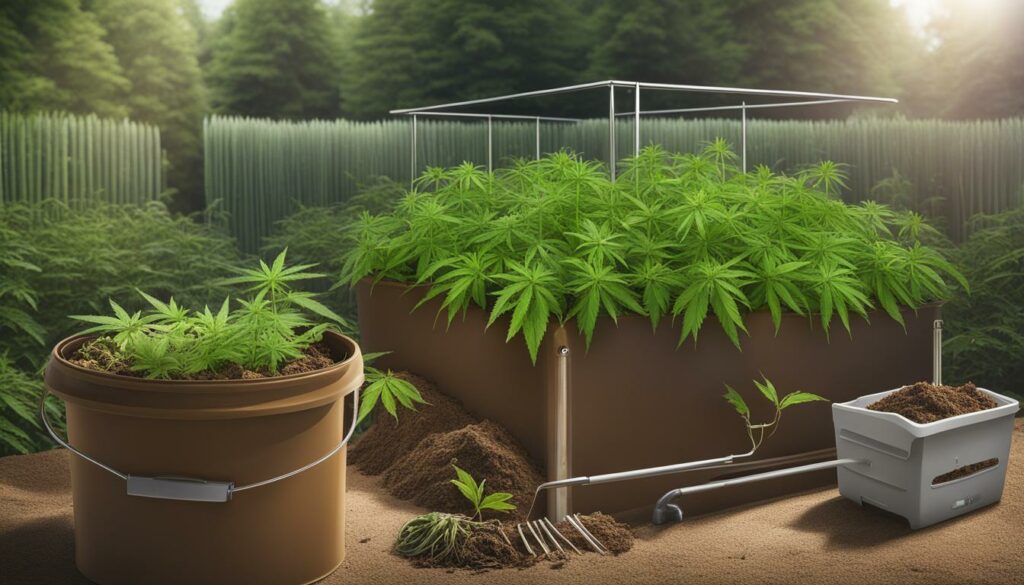
Sustainable Packaging Best Practices
When it comes to sustainable packaging in cannabis cultivation, several best practices can be followed. These include:
- Using biodegradable or compostable packaging materials made from plant-based sources.
- Opting for packaging that is easily recyclable and made from recycled materials.
- Minimizing the use of excessive packaging and choosing designs that are lightweight yet protective.
- Exploring innovative packaging solutions, such as plant-based plastics or hemp-based packaging.
Sustainable packaging not only reduces waste but also promotes a positive brand image and resonates with environmentally conscious consumers. It is essential for cannabis companies to consider the entire lifecycle of their packaging materials and choose options that align with their sustainability goals.
| Benefit | Impact |
|---|---|
| Reduces waste generation | Lessens the environmental impact of the cannabis industry |
| Improves brand image | Attracts environmentally conscious consumers |
| Promotes a circular economy | Encourages the use of recyclable and biodegradable materials |
In conclusion, sustainable packaging and waste management are crucial steps towards minimizing the environmental impact of the cannabis industry. By prioritizing waste reduction, implementing recycling initiatives, and utilizing innovative packaging solutions, cannabis growers can contribute to a greener and more sustainable future.
Regenerative Farming in Cannabis Cultivation
Regenerative agriculture plays a vital role in sustainable cannabis cultivation, promoting soil health, biodiversity, and the reduction of artificial inputs. By implementing regenerative farming practices, cannabis growers can contribute to a greener and more environmentally friendly industry.
One of the key principles of regenerative farming is maintaining soil health. Healthy soil is essential for robust cannabis growth and can help improve the plant’s resilience to pests and diseases. Practices such as cover cropping, crop rotation, and the use of compost and organic matter can replenish soil nutrients, enhance water-retention capacity, and promote beneficial microbial activity.
In addition to soil health, regenerative farming also focuses on preserving biodiversity. By incorporating diverse plant species, growers can create habitats for beneficial insects and organisms that contribute to pest control and pollination. This approach reduces the reliance on synthetic pesticides, fostering a more balanced and sustainable ecosystem within cannabis cultivation.
By adopting regenerative farming practices, cannabis growers can contribute to the long-term sustainability of the industry. These practices not only benefit the environment but also have the potential to improve crop quality and increase overall productivity. As the cannabis industry continues to evolve, embracing regenerative agriculture offers a promising pathway towards a greener and more sustainable future.
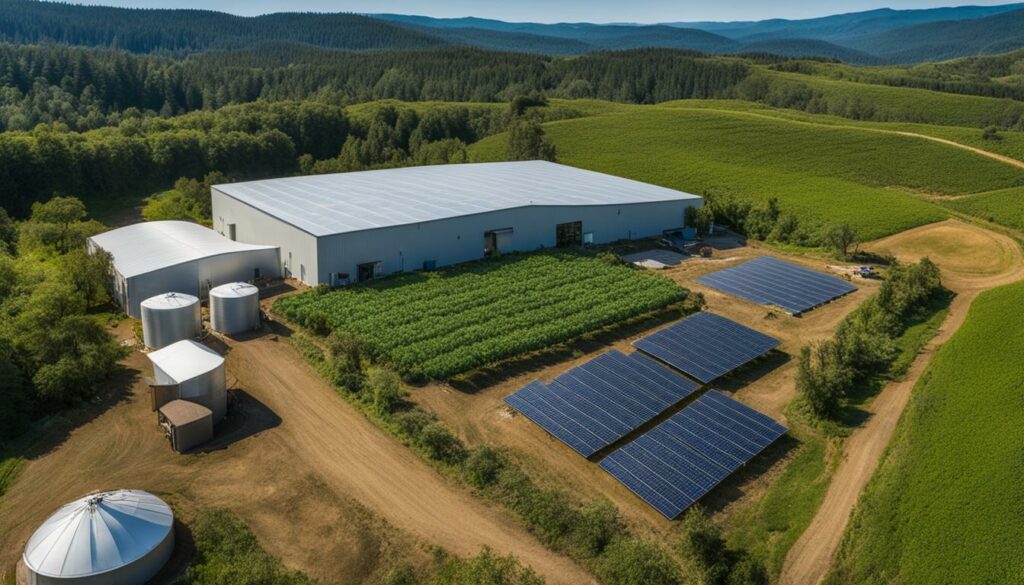
Benefits of Regenerative Farming in Cannabis Cultivation:
- Promotes soil health and fertility
- Enhances biodiversity and ecosystem resilience
- Reduces the need for synthetic inputs and pesticides
- Improves water retention and reduces erosion
- Increases nutrient availability for plants
Case Study: XYZ Cannabis Company
“By implementing regenerative farming practices, we have witnessed significant improvements in our cannabis cultivation. Not only have we reduced our reliance on chemical inputs, but we have also noticed enhanced soil health and increased biodiversity on our farm. Our commitment to sustainability has not only benefited the environment but has also translated into higher-quality cannabis products for our customers.”
– John Smith, Head Grower at XYZ Cannabis Company
The Role of Solar Energy in Sustainable Cannabis Farming
The cannabis industry is increasingly embracing sustainable practices to reduce its environmental impact. One key area of focus is the adoption of solar energy systems for cannabis cultivation. Solar power offers numerous benefits such as reducing carbon emissions, lowering operating costs, and increasing energy efficiency.
By harnessing the power of the sun, cannabis growers can significantly reduce their reliance on fossil fuels and traditional energy sources. Solar panels convert sunlight into clean, renewable energy, providing a sustainable solution for powering indoor and outdoor cultivation operations. This shift towards solar energy not only helps to mitigate climate change but also reduces the industry’s overall carbon footprint.
Moreover, solar energy systems offer economic advantages to cannabis growers. With solar panels in place, cultivators can decrease their energy bills and operational expenses in the long run. The cost savings can be reinvested into other sustainability initiatives or used to improve the quality of the cannabis products.

The Benefits of Solar Energy in Cannabis Cultivation
- Reduced carbon emissions: Solar energy is a clean and renewable power source that produces zero greenhouse gas emissions during operation. By relying on solar power, cannabis growers can significantly reduce their carbon footprint and contribute to mitigating climate change.
- Lower energy costs: Solar panels generate electricity from sunlight, reducing the need for expensive grid electricity. By investing in solar energy systems, cannabis cultivators can lower their energy bills and improve their bottom line.
- Energy efficiency: Solar energy systems are highly efficient and can be tailored to meet the specific energy requirements of cannabis cultivation, whether it’s powering lights, pumps, or ventilation systems. This ensures that energy is used effectively and minimizes waste.
- Environmental stewardship: Choosing solar energy demonstrates a commitment to sustainable practices and environmental stewardship. It sends a positive message to consumers and regulators, showcasing the industry’s dedication to reducing its environmental impact.
The Future of Solar-Powered Cannabis Cultivation
The adoption of solar energy in the cannabis industry is expected to continue to grow as more cultivators recognize the benefits of this renewable power source. With advancements in solar technology and decreasing costs, solar energy systems are becoming increasingly accessible to cannabis growers of all sizes.
As the industry evolves, it is crucial for cannabis cultivators to prioritize sustainability and embrace renewable energy solutions like solar power. By integrating solar energy systems into their operations, cultivators can make a significant positive impact on the environment while also reaping economic benefits. The future of sustainable cannabis farming lies in harnessing the power of the sun.
Related Articles
- What Are the Principles of Sustainable Cannabis Cultivation?
- How to Implement Water Conservation Techniques in Cannabis Growing?
- What Are the Benefits of Organic Cannabis Cultivation?
- How Can Cannabis Growers Reduce Their Carbon Footprint?
- What Are the Challenges of Sustainable Cannabis Cultivation?
Conclusion
The cannabis industry faces environmental challenges, but there is a growing effort to promote sustainable practices. From energy efficiency and water conservation to waste reduction and regenerative farming, cannabis growers and regulators are working towards a greener future.
Continued research, policy changes, and industry collaboration are needed to ensure the long-term sustainability of cannabis cultivation. It is crucial to gather more data on the industry’s environmental impact, particularly in areas such as energy consumption, water usage, air emissions, and waste generation. By filling these knowledge gaps, we can develop targeted strategies to address and mitigate the industry’s environmental footprint.
Cannabis growers are already implementing sustainable energy practices, such as adopting LED lights to reduce energy consumption. Water conservation efforts, such as utilizing automated irrigation systems and reusing water, have the potential to significantly reduce water usage in cannabis farming. Additionally, initiatives are being undertaken to address air emissions and develop sustainable air quality practices.
Regenerative farming techniques, focusing on soil health and biodiversity, offer a promising path for sustainable cannabis cultivation. These practices can minimize the use of artificial fertilizers and pesticides while improving ecosystem resilience. Furthermore, the adoption of solar energy systems is playing a crucial role in reducing carbon emissions and making cannabis farming more environmentally friendly.
By combining these sustainable practices and implementing ongoing research, policy changes, and industry collaboration, the cannabis industry can continue moving towards a greener future. It is essential for all stakeholders to work together to ensure the long-term sustainability of cannabis cultivation and minimize its overall environmental impact.
FAQ
What is sustainable cannabis cultivation?
Sustainable cannabis cultivation refers to the practice of growing cannabis in an environmentally friendly and socially responsible manner. It involves using eco-friendly farming techniques, conserving energy and water, minimizing waste generation, and promoting biodiversity and soil health.
What is the environmental impact of cannabis cultivation?
The cannabis industry has a significant environmental footprint, contributing to high energy consumption, water shortages, air pollution, and waste generation. It has a higher energy footprint compared to other agricultural commodities and can have detrimental effects on local ecosystems if not managed sustainably.
How can energy practices be made more sustainable in cannabis cultivation?
Energy efficiency measures such as using LED lights and renewable energy sources can help reduce energy consumption in cannabis cultivation. Retrofitting existing facilities and implementing smart energy management systems can also contribute to improving sustainability and minimizing carbon dioxide emissions.
What can be done to conserve water in cannabis farming?
Sustainable irrigation practices, including automated systems and water recapturing and reuse, can help reduce water usage in cannabis cultivation. By implementing these practices, growers can minimize water waste and contribute to more sustainable water management in the industry.
How can air emissions be addressed in cannabis cultivation?
Regulations and initiatives are being implemented to address air quality concerns in cannabis farming and reduce emissions. More research is needed to develop sustainable air quality practices, such as using efficient ventilation systems and implementing odor control measures.
How can waste management be improved in the cannabis industry?
The cannabis industry generates significant waste, including consumer packaging and electronic waste. Adopting sustainable packaging options and improving waste management practices can help reduce the industry’s environmental impact. Policy changes and better recycling options are needed to address plastic waste effectively.
What is regenerative farming in cannabis cultivation?
Regenerative farming focuses on maintaining soil health, improving biodiversity, and reducing the use of artificial fertilizers and pesticides. By implementing regenerative agriculture principles, cannabis growers can support sustainable cultivation practices and protect the environment.
How can solar energy contribute to sustainable cannabis farming?
Some cannabis growers are adopting solar energy systems to reduce carbon emissions and lower operating costs. Using solar power can help make cannabis cultivation more energy-efficient and environmentally friendly, contributing to sustainable farming practices.
What efforts are being made to promote sustainable practices in the cannabis industry?
The cannabis industry is increasingly recognizing the importance of sustainability. Growers and regulators are working together to promote energy efficiency, water conservation, waste reduction, and regenerative farming. Continued research, policy changes, and industry collaboration are needed to ensure the long-term sustainability of cannabis cultivation.

